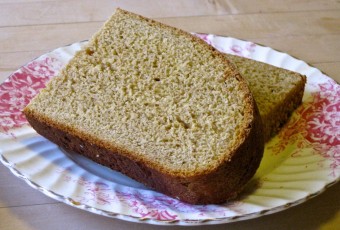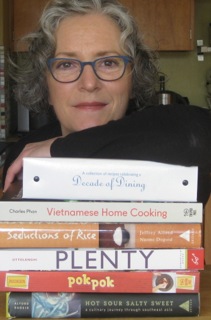
Proven Platter: Rwandan Sweet Potato Bread
Recipe Curator Linda McElroy whips up a Rwandan menu that reflects the simplicity of the cuisine but is tasty and textured.
By Linda McElroy
Hello Diners!
Rwanda is up again – here’s the lowdown on their cuisine: Rwandans eat simple meals made with locally grown ingredients. The food is neither spicy nor hot. Their diet consists mainly of sweet potatoes, beans, corn, peas, millet, plantains, cassava and fruit; they rarely eat meat. Not a lot of options for an exciting meal here you might think. But wait, not so fast!
I’ve come up with a delicious vegetarian stew and a sweet potato bread for you to share with your friends this month. In cruising the Internet for Rwandan recipes, I concluded that I could probably create something that was tastier than anything I’d come across so far. So I took into account the basic ingredients that make up their meager diet and created a stew.
In my research I also discovered the Rwandan Women’s Bakery website. They seek to economically empower village women with life-long skills by teaching them to bake and run a bakery. Their mission is to create and sell nutritious alternatives to existing low-protein foods. One of the ways they accomplish this is to bake bread with nutritious, high-protein add-ins. I’ve taken the liberty of using a traditional Rwandan Honey Bread recipe as a jumping off point and altered it extensively with my own add-ins.
I hope you’ll enjoy this humble repast in keeping with the spirit of the Rwandan people.
Rwandan Sweet Potato Bread
Ingredients
1 pkg. active dry yeast, dissolved in ¾ cup lukewarm water
½ cup honey
¾ cup warm milk
1 egg
4 tablespoons melted butter, cooled
½ teaspoon ground ginger
¼ teaspoon ground cloves
¼ teaspoon nutmeg
½ t teaspoon salt
1 cup mashed sweet potato
3 cups all purpose flour
3 cups white whole wheat flour (or whole wheat pastry flour).
Directions
While the yeast is dissolving in the water, measure the honey into a mixing bowl large enough to make the bread dough. Add the warm milk to the honey first, as this will help to melt the honey and ensure that it will be easy to distribute throughout the dough. Mix well. It will look a bit curdled but not to worry. Next, add all the rest of the ingredients through the mashed sweet potato. Once the yeast has proofed in the water for five minutes, add to the honey mixture.
Next, start by adding all of the white flour and some of the wheat flour. Stir vigorously in the bowl with a wooden spoon, and keep adding more flour as needed to make a dough that does not stick to the bowl. Turn the dough out onto your countertop at this point and continue to knead for a few minutes, adding more flour as necessary so that it doesn’t stick to your hands or the countertop too badly. Keep in mind that the dough should still be moist and not terribly firm.
Form the dough into a ball and placed in an oiled bowl. Cover with a tea towel and leave in a warm spot to double in bulk, about an hour.
After the dough has doubled, fold it over gently on itself a few times, and reshape into a ball. Lightly oil a piece of parchment paper and place your bread directly on the paper. Cover with a tea towel and let rise for an hour, until nearly doubled again.
Begin preheating your oven to 400 degrees. Preheat a baking stone or a heavy-duty cookie sheet. Put it in the oven at least 30 minutes before it’s time to bake the bread.
When the bread is ready to go into the oven, just pick up the edges of the parchment paper and set it onto your stone or cookie sheet.
Bake for 45 minutes. To test doneness, take bread out of the oven and thump it on the bottom. It should sound hollow. If you have an instant read thermometer, it should read 190 degrees when inserted into the loaf. Continue to bake in five minute increments until it is done.
Recipe and photo Courtesy of Linda McElroy
About the Author
Linda and her husband opened Ristorante Machiavelli in Seattle in 1988. After 25 years of cooking in and running a wildly successful neighborhood restaurant they sold the business and retired. Linda loves browsing through cookbooks, and the position of recipe curator provides her with a great excuse to indulge her passion. Linda hopes the dishes she tests and recommends will create a great experience for those who replicate her work in their kitchens.

